

The Crew on the Endeavour. Seascape Navigator - The Museum and Art Gallery of the Northern Territory. Set in a scenic location overlooking the Arafura Sea is the Museum and Art Gallery of the Northern Territory (MAGNT) the premier cultural institution in the Northern Territory.
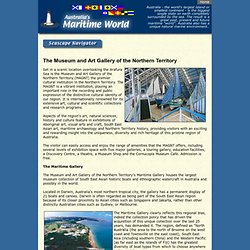
The MAGNT is a vibrant institution, playing an important role in the recording and public expression of the distinctive cultural identity of our region. It is internationally renowned for its extensive art, cultural and scientific collections and research programs. Aspects of the region's art, natural sciences, history and culture feature in exhibitions of Aboriginal art, visual arts and craft, South East Asian art, maritime archaeology and Northern Territory history, providing visitors with an exciting and rewarding insight into the uniqueness, diversity and rich heritage of this pristine region of Australia. European discovery and the colonisation of Australia. European mariners Francesco Bartolozzi (1727-1815), Captn.
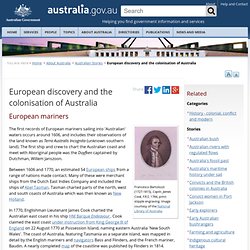
James Cook, F.R.S, 1784, print: stipple engraving. Image courtesy of the . The first records of European mariners sailing into 'Australian' waters occurs around 1606, and includes their observations of the land known as Terra Australis Incognita (unknown southern land). The first ship and crew to chart the Australian coast and meet with Aboriginal people was the Duyfken captained by Dutchman, Willem Janszoon. Between 1606 and 1770, an estimated 54 from a range of nations made contact. In 1770, Englishman Lieutenant James Cook charted the Australian east coast in his ship . South Seas - Voyaging Maps. Australia on the map. A Timeline of unveiling Australia to the world Includes the ‘AOTM Landings List 1606 – 1814’ from Willem Janszoon* to Louis de Freycinet and Matthew Flinders.

It is a datebase of concise information about landings on and sightings of Australian coasts from recorded vessels from 1606 to 1814 in chronological order. Flags denote the nationality of the ships’ country of origin. Modern flags are used. All vessels’ names are in italics. This ‘Landing List’ includes those navigators who made a recorded contact, including visual contact with Australia during the period, as well as some relevant landmarks in the mapping of Australia. * Surnames ( Family names) were relatively uncommon in 17th century Holland. Janszoon is pronounced like Yahns-zone with dialectic differences. ABC TV: Captain Cook. Endeavour-2.jpg (JPEG Image, 610 × 413 pixels) Discovery of Australia. The Discovery of Australia Aboriginal people discovered Australia, and have lived in Australia for more than 50 000 years.
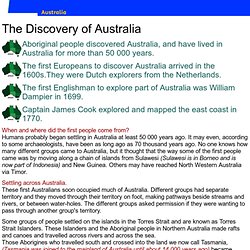
The first Europeans to discover Australia arrived in the 1600s.They were Dutch explorers from the Netherlands. The first Englishman to explore part of Australia was William Dampier in 1699. Captain James Cook explored and mapped the east coast in 1770. When and where did the first people come from? Settling across Australia. Some groups of people settled on the islands in the Torres Strait and are known as Torres Strait Islanders. How did they live? The Aboriginal communities were run by older members of the group, known as elders.
Australian Aboriginal Flag You can read more about Australia's Aboriginal People from the links on this kidcyber page When did the first European explorers arrive? In 1616, another Dutchman, Dirk Hartog landed on an island off the coast of Western Australia. William Dampier Back to Australia May 2013 copyright © kidcyber us@kidcyber.com.au. Discovery of Australia. Key points When European sailors began entering ‘Australian' waters in the early 1600s, they called it Terra Australis Incognita (unknown land of the South).
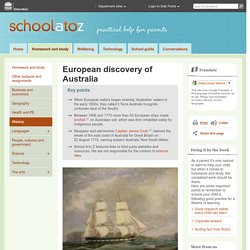
Between 1606 and 1770 more than 50 European ships made landfall on Australian soil, which was then inhabited solely by Indigenous people. Australian Journeys. The Human Journey – Episode 3 (1999) clip 2 on ASO. Clip description When the wandering tribes from Africa reached the end of South-East Asia, they looked out across the sea to another land mass just 90 kilometres away, Australia.

With remarkable planning and design skills, they built and provisioned sea-worthy vessels to carry them over the water to colonise this new frontier. Curator’s notes. South Land to New Holland - Introduction. Australian Aboriginal history timeline. 120,000 Analysis of pollen and charcoal giving a date of 120,000 BP suggests that people were using fire to clear land in the Lake George basin in the Southern Tablelands of NSW, about 30 kms north-east of Canberra.68,000 Current estimates for the arrival of Aboriginal people in Australia [2].60,000 Age of Lake Mungo 3 human remains (age range between 56,000 and 68,000 years), south-western NSW, 987 km west of Sydney.
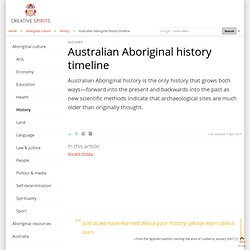
Footprints discovered at Lake Mungo are believed to be 23,000 years old. Lake Mungo, New South Wales. Ancient camp sites have been found in this area.56,000 Suggested age of two north Australian sites (Nauwalabila and Malakunanja, about 300 kms east of Darwin). Archaeological evidence suggests that a rock shelter was used by people at a site in Arnhem Land (400 kms east of Darwin) in the Northern Territory. Rottnest Island, Western Australia. Australian History. Australian Discovery. Who Got to Australia First? - GATEWAYS - National Library of Australia. Cover of Chinese translation of Menzies’ book First map of Australia by Nicolas Vallard.
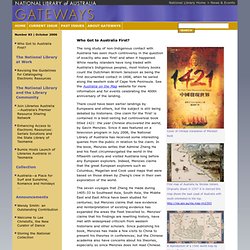
Originally drawn in 1547 it is claimed this map shows the east coast of Australia with south orientated to the top. A reproduction of a 1566 world map by Nicolas Desliens. With south orientated at the top, the top left corner has a large land mass that is claimed to be Australia, charted from Chinese voyages. The long study of non-Indigenous contact with Australia has seen much controversy in the question of exactly who was ‘first’ and when it happened.
There could have been earlier landings by Europeans and others, but the subject is still being debated by historians. The seven voyages that Zheng He made during 1405–33 to Southeast Asia, South Asia, the Middle East and East Africa have been studied for centuries; but Menzies claims that new evidence and reinterpretation of existing evidence has expanded the areas the fleet travelled to. Australia on the Map.